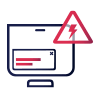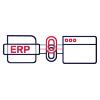
More stakeholders
B2B purchases often involve multiple people within a company, requiring approval workflows and customized pricing.


For most B2B product sellers, e-commerce is something to tick off a never-ending to-do list.
The problem with that is B2B commerce has needs that can’t usually be accommodated by typical commerce tooling.
The result? B2B buyers struggle to work with a web store that hasn’t been built with their needs in mind, and thus require extra support, handholding, and incentive to avoid churning.
So much for shortening that to-do list.
A web store that is optimized for the B2B customer journey accommodates typical B2B complexity, which in turn drives value faster for all your stakeholders.
Not all web stores are created equal. B2C platforms are optimized to focus on quick one-off purchases for individual consumers. B2B e-commerce requires a different approach.
Here’s why:

B2B purchases often involve multiple people within a company, requiring approval workflows and customized pricing.

B2B orders can be significant, making accurate information and streamlined processes crucial to avoid errors.

Features like complex order routing, customized pricing structures, and account management are essential for B2B transactions.
Studies that we have conducted in the past conclude that, on average, the entire B2B buying process takes 28.2 days.
This means that the seamless process experience by B2C customers is not as easy to achieve as in B2B e-commerce.
In fact, 85% of B2B buyers have frustrations when ordering online, and 75% of them would switch suppliers if they offered a superior experience.
It’s not all bad news – the silver lining is 73% of B2B buyers still prefer placing complex orders online.
For B2B product sellers, that means the priority lies in delivering a faultless experience to enable these complex orders.
The fact is most commerce tools don’t account for B2B complexities. Here are some common examples of mishaps that rise from the wrong kind of tooling:

Imagine seeing the wrong stock levels or incomplete product listings. Frustrating, right?

Can your web store handle complex orders with multiple shipping locations, or varying pricing rules?

Shouldn't your customers be empowered to find the products they need on their own?
Sound familiar?
By understanding the B2B customer journey and optimizing your ecommerce experience, you can create a win-win situation for your business and your customers.

Our platform can help.
Here’s how to get started with improving your B2B web store.
This will help you identify pain points and opportunities to improve. Here’s how to get started:
Know your goal and gather information about customer needs and preferences that contribute towards meeting the goal. Be clear about the reason you are creating the map and identify possible blockers within this journey.
Create personas and customer segments. Build realistic profiles of different customer types to better grasp their needs, motivations, and behaviors.
Break down the customer journey into stages such as awareness, buying, and post-purchase to clearly visualize their path.
List all your B2B customer touchpoints and highlight areas where customers successfully engage with your business. Document their actions and emotions at each step.
Pinpoint hurdles and pain points that hinder customers from completing their journey effectively.
Leverage collective intelligence within your organization to brainstorm and propose actionable improvements for the customer experience.
Create a straightforward visual map illustrating journey stages and key customer touchpoints.
Share your visual journey map with relevant stakeholders to validate assumptions and refine improvements.
Actively implement identified improvements to enhance the overall customer journey.
Remember, the goal is to make your B2B customers’ experience better and more streamlined throughout their interaction with your business.
Educate them on using your new B2B ecommerce platform to its full potential.
Here are 5 easy steps to onboard customers in B2B e-commerce.
Look for features that streamline complex orders and empower your customers.
Sana Commerce Cloud utilizes our ‘Impersonate’ function, which enables customer service representatives to access the web store with a customer account, to accelerate troubleshooting any potential issues.
Optimizing your B2B web store isn’t always straightforward. Common challenges include:
To ensure the successful implementation of optimizing the customer journey, it is imperative to secure the endorsement of senior executives. The absence of their backing could potentially lead to disruptions due to competing priorities or insufficient resource allocation. Moreover, senior executives need to grasp the inherent value of customer journey mapping and demonstrate a willingness to invest both time and resources into the undertaking.
Did you know that 84% of B2B buyers believe that an easy and accurate online web store experience is important?
The solution to building a compelling case for senior management regarding the significance of B2B e-commerce involves leveraging statistics like this from reports. For more statistics that could help you build a business case, visit our B2B Buyer Report.
This presents a case where you have perhaps not launched your e-commerce platform, or you simply don’t have enough customers to analyze their behavior. This can result in a lack of data to implement changes.
An idea to overcome this hurdle would be to test your web store internally with normal people that can pick up on hurdles when placing themselves in tricky buying situations. You could also leverage focus groups for an external point of view.
In the ever-evolving world of B2B e-commerce, a commitment to understanding, adapting, and optimizing the customer journey is key to creating lasting customer relationships and thriving in a competitive landscape.
But where do you begin?
Our comprehensive guide equips you with the knowledge and strategies to excel in B2B e-commerce. However, before diving in, take a step back and assess your current B2B commerce platform.
To understand more and equip yourself with the knowledge and strategies to excel in the world of B2B e-commerce, dive into the insights and real-world examples in our comprehensive guide. Don’t miss out – download our B2B Buyer Report now.

Discover what B2B buyers expect in 2025 – and stay ahead of the competition.